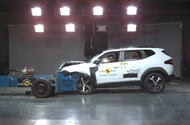Citroën and Dacia are raising some important questions about the future of car safety standards and their impact on affordability. As the automotive landscape evolves, the push for stricter safety regulations, particularly from organizations like Euro NCAP, is becoming a hot topic. The leaders of these brands argue that while safety is paramount, the increasing demands for advanced safety features could make their models less accessible to everyday consumers.
What’s Driving the Debate on Car Safety Standards?
The heads of Citroën and Dacia, Thierry Koskas and Denis Le Vot, respectively, have voiced concerns that the latest safety tests may not align with what many consumers can afford. They acknowledge the importance of improving vehicle safety but argue that the standards set by Euro NCAP are becoming increasingly unattainable for budget-friendly models. For instance, Dacia’s Duster, priced at around £18,000, received only three stars in Euro NCAP’s ratings, while more expensive models like the Mercedes-Benz E-Class and Skoda Superb, priced at £54,000 and £35,000 respectively, easily achieved five stars.
The crux of their argument lies in the fact that to earn the coveted five-star rating, vehicles must not only excel in crash protection but also be equipped with the latest crash avoidance technologies. This includes both passive safety features, such as airbags and crumple zones, and active systems like advanced driver assistance technologies. As the standards tighten, the challenge for manufacturers focused on affordability becomes even greater.
Are Stricter Standards Necessary?
Richard Billyeald, a board member of Euro NCAP and chief technical officer at Thatcham Research, defends the higher standards, emphasizing their role in pushing the boundaries of vehicle safety. He argues that while legislation sets a baseline for safety, Euro NCAP aims to encourage innovation and improvement in vehicle technology. This perspective is crucial as it aligns with the broader goal of reducing traffic-related fatalities, a mission encapsulated in Euro NCAP’s Vision Zero initiative.
However, the reality is that as technology advances rapidly, cars can quickly become outdated in terms of safety ratings. Koskas points out that a vehicle that once held a solid four-star rating could potentially drop to zero stars under new testing criteria, not because it has become less safe, but because the bar has been raised. This creates a dilemma for manufacturers who strive to keep their vehicles affordable while meeting these evolving standards.
How Do Consumers Perceive Safety Ratings?
For many car buyers, safety ratings are a key factor in their purchasing decisions. The star ratings provide a straightforward way to gauge a vehicle’s safety performance. But as the standards change, it raises questions about how relevant these ratings will be for budget-conscious consumers. Koskas and Le Vot have expressed that while they comply with existing regulations, the relentless pursuit of higher Euro NCAP ratings may not reflect the actual safety of their vehicles.
Interestingly, even with mandatory active safety systems, many drivers find these features intrusive. Koskas admits to disabling the systems in his own car because they can be annoying. This sentiment is echoed by other drivers who appreciate the intention behind these technologies but find them cumbersome in practice. Billyeald acknowledges this issue and emphasizes the need for regulators to ensure that safety systems are user-friendly, maximizing their benefits without causing distraction.
What’s Next for Euro NCAP?
Starting next year, Euro NCAP will introduce even more stringent assessments that go beyond crash scenarios. The new evaluations will consider driver engagement, assistance systems, and emergency response capabilities, categorizing them into four areas: Safe Driving, Crash Avoidance, Crash Protection, and Post-Crash Safety. These updates aim to align safety assessments with the latest technological advancements in vehicles, ensuring that safety remains a priority as cars become more complex.
Understanding Euro NCAP Ratings
To clarify what these ratings mean for consumers, here’s a quick breakdown:
– **Five stars**: Excellent performance in crash protection and equipped with advanced crash-avoidance technology.
– **Four stars**: Good performance but does not meet the highest standards in all areas.
– **Three stars**: Average safety performance, providing a medium standard of protection.
– **Two stars**: Below-average performance in key areas, offering nominal crash protection.
– **One star**: Minimal crash-avoidance technology, meeting only legal requirements.
– **Zero stars**: Meets basic legal standards but lacks critical safety technology.
The big takeaway? The conversation around car safety isn’t just about meeting regulations; it’s about balancing safety with affordability. As manufacturers navigate these challenges, consumers should stay informed and consider how safety ratings impact their choices. Start with one change this week, and you’ll likely spot the difference by month’s end.

